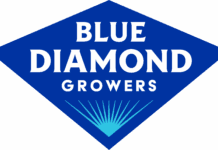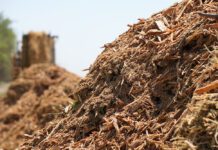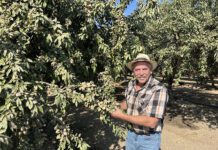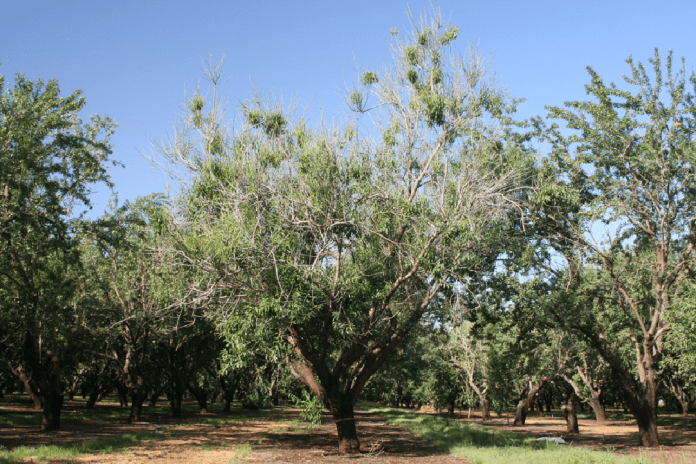
Researchers have essentially ruled out disease as the cause of non-infectious bud failure (NBF) in almonds, instead hypothesizing genetics are at the root of the malady. Although they have yet to pinpoint the exact cause, more recent research suggests epigenetic factors may be involved in NBF expression. Epigenetics deal with how genes work, including their communication and whether they’re turned on or off.
In addition, researchers believe increased clonal age may play a role in NBF. Tom Gradziel, a UC Davis plant science professor, said other unknown genetic and chemical interactions also may be in play because technology hasn’t yet advanced to the stage to detect them.
The researchers’ next step is to identify where methylation, which involves a methyl chemical group that attaches to DNA, blocking gene communication and essentially turning it off, occurs within the genome. They hope to pinpoint potentially affected gene or gene features. This project is led by Jonathan Fresnedo-Ramirez, an Ohio State University assistant professor of plant breeding and genetics.
Although some growers believe stress is responsible for NBF, Gradziel pointed to potential genetic causes and genes that deal with winter and summer dormancy. But he said stressors, such as hot weather and irrigation cutbacks during specific parts of the growing season, may speed symptom expression.
“The bud failure is there and will show up,” Gradziel said. “If you put a lot of stress on the trees, it will just show up earlier than it typically would.”
The malady isn’t limited to California orchards and also has been identified in Australia, Spain and Israel, to name a few countries.
NBF Symptoms
Non-infectious bud failure was first observed in the early 1900s but wasn’t formally described until 1944. At the time, it was thought to be a viral disease, but no study has identified an infectious agent. As a result, it is thought to be genetic.
In trees with NBF, vegetative buds formed in the previous season die instead of emerging in the spring. Affected buds tend to occur on shoots formed in warmer temperatures later in the growing season.
Terminal buds typically exhibit greater mortality than basal buds in NBF shoots. When unaffected buds break dormancy in the spring, lateral shoots grow to create a witch’s broom-like branching pattern, hence the nickname “crazy top.” Rough bark also has been associated with affected trees in the first five years of a tree’s life.
Nut set isn’t affected the first year of NBF symptoms. But growth and flower bud development are reduced in subsequent years, causing yield losses up to 50%, according to research by UC Davis Pomology Professors Dale Kester and Warren Micke.
NBF severity varies among cultivars, with Carmel being the most widely affected. The malady has become increasingly common in Nonpareil as well.
Epigenetics Enlisted
With advancements in genetic research, scientists in the past few years have focused on epigenetics to help answer the NBF problem.
Although it may sound like a term relegated to the laboratory, Gradziel said it occurs all around us. Take humans who have brown hair when they’re young, for example.
The hair coloring is due to a gene, a DNA segment that contains instructions for, in this case, pigmentation. As people age, their hair eventually turns gray.
The gene for brown hair remains in the same position within the genome, an organism’s entire genetic library, as it always has. What has changed is a chemical group has turned off the brown hair gene’s communication.
Gradziel said researchers hypothesize a similar process is occurring in almond cultivars with NBF because they see it appear much earlier in trees grafted with budwood of increased clonal age.
The original Carmel tree is still alive in Kern County, and he said basal epicormic meristems, or budwood closest to the original tree bud, will produce offspring where NBF is suppressed, and symptoms are delayed for about 10 years.
But varieties, and particularly Carmel, propagated with budwood several generations removed from the mother tree will show NBF symptoms much earlier in their life.
“In some sense, the message with repeated cycles gets distorted,” Gradziel said. “It no longer gives the proper communications. We could go back to the original Carmel tree and we get the original message.”
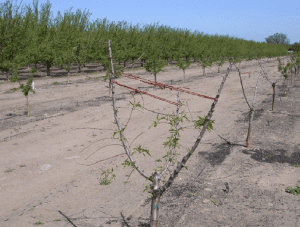
Going Back in Time
Bill Bright, owner of Bright’s Nursery in Le Grand, Calif., did just that and went back to the Carmel mother tree he maintains. He used basal epicormic meristem propagation to develop budwood trees only a generation removed.
The result was Carmel O.S., or Original Source, which Bright licensed to Yuba City-based Sierra Gold Nurseries to propagate second-generation trees, said Sierra Gold CEO Reid Robinson.
With non-infectious bud failure, Robinson said it’s not if the malady will show up but when. In marketing the Carmel O.S. selection, he said they hoped it would significantly delay the onset of symptoms.
“With varieties that are susceptible, and primarily Carmel, you always are trying to play this game with how far back in time can I go to get this material to propagate,” he said. “You can do all that, and you can produce a tree that has less of a chance of getting bud failure. But bud failure genes also depend on where the tree is grown, the type of drought stress it has been through and other climactic conditions.”
For several years, Robinson said the new line showed very little NBF with 7- to 8-year-oldtrees having 1% or less.
“We got really excited with this O.S. source and it worked out really well for a long time,” he said. But in the past three years, growers with Carmel O.S. are reporting slightly more NBF. Robinson pointed to the ongoing drought, higher summer temperatures, warmer winters and even unknown factors as possible reasons for the uptick.
Carmel Still Has Value
Despite the black eye Carmel has received because of NBF, Gradziel said the variety still has value because of its desirable kernel and bloom overlap with Nonpareil. As a smaller tree, Carmel also doesn’t compete as much for sunlight with Nonpareil as some of the other taller pollinizer varieties do.
Robinson agreed, saying they still have customers who want Carmel.
“There are certain growers who really like Carmel with Nonpareil,” he said. The nursery requires growers purchasing the cultivar to sign a waiver acknowledging they understand the risks tied to NBF.
“When we sell Carmel O.S., the chance of bud failure is still out there,” he said. “But compared to another Carmel, there’s a better chance that your trees will have a lower percentage of bud failure and it will happen later in a tree’s life.”
To Leave a Tree or Replace?
Should growers plant Carmel and begin to see NBF, Gradziel said the decision to keep or remove trees depends on their age.
“If NBF occurs when the tree is fairly well established, say in year seven or eight, and that tree is well developed with major scaffolding and a lot of branches, it’s sort of self-pruning,” he said. “You’re better off economically leaving it in the orchard.”
But if trees are younger and don’t have an established scaffolding, Gradziel said they’ll never develop the strong secondary architecture on which the crop grows. In this case, he recommended removing them.
And detecting the problem early is critical in reducing the time to a break-even yield, according to a Sacramento Valley Orchard Source newsletter article by UCCE Orchard Systems Advisor Luke Milliron and Farm Advisor Emeritus Joe Connell.
“The first opportunity to observe NBF in a new orchard is the spring of the second leaf,” Gradziel said. “Observations must be made in March or April when symptoms are clearly visible since new growth from the surviving buds can mask NBF later in the season.
“If trees are long-pruned in the first dormant season, the symptoms will be more obvious in the second leaf. Short pruning tends to mask the symptoms until pruning is reduced in the second or third dormant season.”
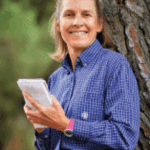
Vicky Boyd | Contributing Writer
A veteran agricultural journalist, Vicky Boyd has covered the industry in California, Florida, Texas, Colorado, the South and the Mid-South. Along the way, she has won several writing awards. Boyd attended Colorado State University, where she earned a technical journalism degree with minors in agriculture and natural resources. Boyd is known for taking complex technical or scientific material and translating it so readers can use it on their farms. Her favorite topics are entomology, weeds and new technology. When she’s not out “playing in the dirt,” as she calls agricultural reporting, Boyd enjoys running, hiking, knitting and sewing.







